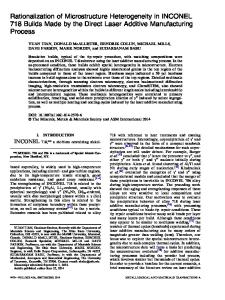Microstructure and Properties of Inconel 718 Fabricated by Directed Energy Deposition with In-Situ Ultrasonic Impact Pee
- PDF / 3,672,014 Bytes
- 13 Pages / 593.972 x 792 pts Page_size
- 104 Downloads / 296 Views
ADDITIVE manufacturing (AM) has attracted significant attention for metallic component manufacturing in that it offers a wide variety of advantages compared with traditional manufacturing methods such as reductions of material waste, processing complexity, lead time, and transportation cost, and also it provides much more freedom concerning the geometry and alloy constituent design.[1,2] Powder-based laser metal deposition (LMD) is a directed energy deposition (DED) type of metal AM techniques. In this process, a melting pool on the build surface is generated by the laser beam first. A nozzle simultaneously feeds metal powders into the melt pool. This creates beads that are welded to one YACHAO WANG and JING SHI are with the Department of Mechanical & Materials Engineering, College of Engineering and Applied Science, University of Cincinnati, Cincinnati, OH 45221. Contact e-mail: [email protected] Manuscript submitted May 27, 2019.
METALLURGICAL AND MATERIALS TRANSACTIONS B
another. The process is repeated layer by layer until the entire structure is formed on the substrate. In general, LMD is still regarded as less competitive in manufacturing structural components as compared to the traditional manufacturing methods, because of several major limitations, including porosity,[3] low surface precision,[4] detrimental residual stress distribution,[5] and hard-to-control microstructure.[6] To eliminate material defects and thus improve the mechanical properties of additively manufactured metal parts, various post-treatment methods have been adopted, such as post-heat treatment,[7] isostatic pressing,[8] and shot peening.[9] Although the post treatments could enhance the mechanical properties to a certain extent, they have various disadvantages, such as high energy consumption, long lead time, and adverse effect on part precision. Therefore, in-situ material modification during metal AM processes has become an important research topic thanks to the simplified processing procedure, high integrability, and reduced cost. More importantly, in-situ material modifications may improve
the mechanical properties and microstructure of the entire component, instead of being limited to the surface region. In the related literature on metal AM research, various techniques traditionally developed for surface modification have been explored for AM applications. For instance, Aimangour demonstrated the improved surface quality and hardness of additively manufactured 17-4 stainless steel by post-shot peening.[10] Post-heat treatment of shot peened parts further promoted the surface hardening effect.[11] Similarly, Uzan et al. applied post-shot peening to improve the fatigue properties of SLM-produced AlSi10Mg.[12] Laser shock peening was also applied as an effective post-treatment measure to refine surface microstructure and obtain multi-directional mechanical twins.[13] Post-laser shock peening was reported as helpful to obtain homogenous microstructure and better shape memory effect for additively manufactured NiTi alloy.[14] Donoghue et al.[15]
Data Loading...











